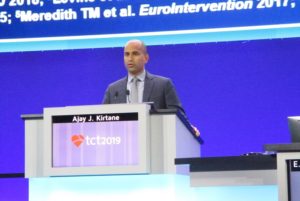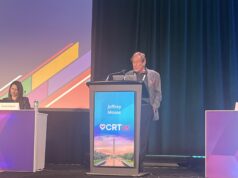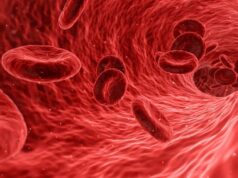
Further evidence for a shorter duration of dual antiplatelet therapy (DAPT) in patients implanted with a drug eluting stent has been provided with the presentation of two studies at Transcatheter Cardiovascular Therapeutics (TCT 2019; 24–29 September, San Francisco, USA).
Data from EVOLVE Short DAPT demonstrate that shortened three-month DAPT did not increase myocardial infarction (MI) or stent thrombosis (ST) in high bleeding risk (HBR) patients treated with a drug-eluting stent. Lead investigator Ajay J Kirtane (New York-Presbyterian/Columbia University Irving Medical Center, New York, USA) outlined the findings to delegates in a late-breaking trial session. He was immediately followed by Ken Kozuma (Teikyo Universty, Tokyo, Japan), who presented findings from MODEL U-SES, which found that three-month DAPT after implantation of a bioresorbable polymer sirolimus-eluting stent (BP-SES) was non-inferior in net adverse clinical events to an adjusted cohort of longer DAPT. Both trials were prospective, single-arm studies.
Explaining the background, Kirtane referred back to 2006, “when numerous guidelines were updated”.
“At that time, the recommendations for dual antiplatelet therapy following a DES were extended to about a year. And that was done based upon observational data demonstrating low rates of stent thrombosis and myocardial infarction. We do know, subsequent to that, that an extension of dual antiplatelet therapy is associated with higher bleeding rates, despite these low rates of myocardial infarction and stent thrombosis, with a net neutral-to-perhaps-negative effect upon mortality, because of the bleeding risk occurring.”
EVOLVE short DAPT was powered to define the safety of three-month DAPT in patients at high bleeding risk treated with Synergy (Boston Scientific), a thin-strut everolimus-eluting stent with an ultrathin abluminal bioabsorbable polymer coating. Drug release and polymer degradation are complete within four months of implantation. Kirtane said: “With the demonstration of low rates of stent thrombosis in five years or more in bleeding risk subjects on standard DAPT durations, it is therefore a somewhat optimised platform to test short duration dual antiplatelet therapy.”
Investigators enrolled 2,009 high bleeding risk patients (age ≥75 years with bleeding risk outweighing benefit of DAPT >three months, chronic anticoagulation, major bleeding within 12 months, history of stroke, thrombocytopenia, or renal insufficiency/failure) at 110 sites globally. Patients with acute MI or complex lesions were excluded.
“Patients had to undergo successful uncomplicated PCI,” Kirtane clarified, “continue on dual antiplatelet therapy for three months, and then at three months, discontinuation of a P2Y12 inhibitor was initiated as per the protocol in patients who were event free.”
Clinical follow-up at three months was 95.2% (n=1,912). Of those, 77.7% (n=1,487) were eligible to discontinue the P2Y12 inhibitor. The analysis population for the secondary endpoint of BARC 2,3, or 5 bleeding was 1,032; 455 patients were excluded as they were on anticoagulation.
One co-primary endpoint assessed death or myocardial infarction between three and 15-months post-procedure compared for non-inferiority to a propensity-adjusted historical limus-eluting stent control group receiving 12-month DAPT. The event rate for patients who received three-month DAPT (n=1,454) was 5.6% vs. 5.7% in the historical control group receiving 12-month DAPT (n=1,493, non-inferiority p=0.0016). The second co-primary endpoint of ARC definite/probable ST in patients with three-month DAPT between three and 15 months was also met, with an incidence of 0.3% compared to a 1% performance goal (non-inferiority p<0.0001). The secondary endpoint was the rate of BARC 2, 3, or 5 bleeding in patients compared for superiority to the propensity-adjusted historical control; this was 6.26% (n=974) in patients receiving three-month DAPT compared to 4.17% in the 12-month DAPT group (n=947) (2.1%, 95% confidence interval [CI] -0.10–4.29, p=0.98).

Kirtane summed up: “The study met both coprimary endpoints, despite incomplete event adjudication in the control group, with favourable rates of ischaemic outcomes from three to 15 months after discontinuation of P2Y12 inhibitor. These data support the use of Synergy with three-month duration of DAPT in high bleeding risk patients.”
MODEL U-SES evaluated the safety of three-month DAPT after implantation of Ultimaster (Terrumo), a bioresorbable polymer sirolimus-eluting stent. A secondary objective was to investigate the appropriateness of P2Y12 receptor inhibitor monotherapy compared to aspirin monotherapy after three months.
Kozuma said: “Recent guidelines recommended short DAPT up to three months only in high bleeding risk patients. However, short DAPT may be beneficial for any patient. Aspirin may be more associated with bleeding complications than P2Y12 inhibitors.”
The study population consisted of patients with acute coronary syndrome (ACS) or stable coronary artery disease requiring PCI, who were considered suitable for short DAPT to three months at the physician’s discretion. The primary endpoint was a composite of all-cause death, myocardial infarction (MI), stroke (ischaemic and haemorrhagic), Academic Research Consortium (ARC) stent thrombosis, and serious bleeding (BARC 3 or 5) during the 12 months after stent implantation. The major secondary endpoints were a comparison of the incidence of each event for each continued antiplatelet drug (aspirin vs. P2Y12 inhibitor monotherapy).
Kozuma and colleagues compared the 1,616 patients enrolled in the trial and implanted with the SES (Ultimaster, Terumo) who stopped DAPT after three months with a control group from the CENTURY II BP-SES study of 542 patients who received the same stent but continued DAPT for one year.
The incidence of the composite ischaemic and bleeding endpoint was 4.4%. After adjustment for a propensity score subclassification, the primary endpoint was similar in both cohorts (MODEL U-SES 4.3%, CENTURY II BP-SES 5.7%, adjusted difference –3.7, p noninferiority <0.0001). In a landmark analysis at 90 days for all-cause death, MI, stroke, ST, and BARC 3 or 5 bleeding, with a propensity score adjustment, the incidence rate was 2.2% in the MODEL U-SES cohort and 3.7% in CENTURY II (hazard ratio [HR] 0.59, 95% CI 0.27–1.3, p=0.19).
Kozuma said: “If you look at the landmark analysis, they are almost similar but … periprocedural MI was higher in CENTURY II group. If we look at the ischaemic composite endpoint [cardiovascular death, stroke, MI, and ST], MODEL U-SES tended to be lower but it was not significant [0.9% vs. 2%, HR 0.46, 95% CI 0.14–1.44, p=0.18]. Bleeding complications also tended to be lower in MODEL U-SES as compared to CENTURY II [0.5% vs. 1.6%, HR 0.33, 95% CI 0.10–1.08, p=0.07].”
In a 90-day landmark inverse probability of treatment weighting analysis in the MODEL U-SES cohort of the primary endpoint after monotherapy began, the rate was 2.5% in both the P2Y12 monotherapy group and the aspirin monotherapy group (hazard ratio [HR] 1.14, 95% CI 0.58–2.22). There was also no difference between the monotherapies in ischaemic events or bleeding rates.
Kozuma acknowledged that using a propensity score adjusted analysis may not have compensated sufficiently for the selection bias of the study, given that considerable baseline differences were observed. “And,” he added: “the comparison between aspirin and P2Y12 inhibitors was not randomised, so the safety and efficacy of each antiplatelet monotherapy cannot be conclusive. Direct comparison between P2Y12 inhibitor and aspirin would be necessary to confirm the efficacy and safety of this monotherapy in a randomised fashion.”
In conclusion, he said: “This study demonstrated that three-month DAPT was non-inferior to an adjusted cohort of longer DAPT after BP-SES implantation in net adverse clinical events. P2Y12 inhibitor monotherapy was almost equivalent to aspirin monotherapy after three months, in terms of both bleeding and thrombotic events.”
Commenting on the significance of both studies, Kirtane told Cardiovascular News: “Overall, we have seen at TCT 2019 several studies demonstrating that shorter durations of DAPT are permissible for higher bleeding risk patients, which is good news for physicians and the patients they treat.”










